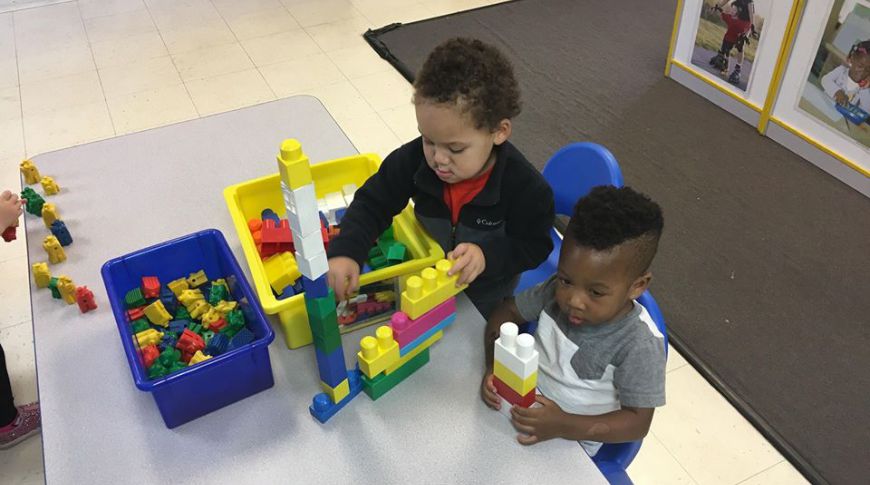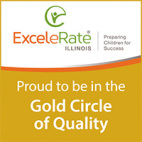Transition Plan
The quality standards set forth in ExceleRate Illinois call for high quality care and learning programs to have and implement written transition plans for the children and families. The purpose of these plans are to identify and outline activities and strategies that “facilitate the transition of children and families into and out of classrooms, early learning environments, community services, and school settings including transition to kindergarten.” (ExceleRate Gold Circle of Quality, Standard 2B).
Once Upon A Time Child Care has long implemented a variety of strategies to successfully transition children and families transition through these life passages successfully and confidently. This policy can be found in our Parent Handbook, Staff Handbook, and Risk Management Plan. It is also available to the community/school stake holders on our website.
This document will summarize activities that Once Upon A Time do to help children and families navigate necessary transitions.
The five key transitions this policy will focus on:
1. Transitions into a program;
2. Transitions while enrolled;
3. Transitions within the program day;
4. Family transitions outside a program; and
5. Transitions when leaving a program.
1. Transitions INTO our Center.
a. Prospective family visits—families considering enrolling their children are invited to visit the Center for a tour. During this tour, families learn of our approach to teaching and learning (philosophy), see our learning environments, meet our teaching staff, and have opportunities to have their questions answered. The goal of this visit is to make sure that our Center is a “good fit” to prospective families.
b. New family orientation sheet—we use an orientation checklist to make sure the enhanced orientation is complete. The orientation includes: a tour of the building, showing children where their cubby is, meeting teaching staff, playing in their classroom with peers and teachers, conversations between parents and teachers and between children and teachers, learning more about the OUAT policies and practices, learning drop-off and pick-up procedures, and much more. Teachers also speak with parents about a child’s first day and talk about how we will help the parent and child with common separation issues. The goal of orientation is to help children and families feel comfortable and part of the OUAT family and ease the child into their first day of attendance.
c. Family information sheet—when a family chooses to enroll, we provide the parents with several forms to complete. One form is a “Family Information Sheet.” This four-page document provides parents the opportunity to tell us all about their child and their family. From this sheet we learn about child interests, typical guidance approaches, family dynamics, health history, etc. After this form is returned the Director, Assistant Director and teachers of the room, read the form as a means of getting to know the child and family better. A copy is put into the classroom binder, and the original is placed in the child’s file in the office.
d. Family Handbook—upon enrollment parents are provided with a comprehensive Family Handbook. This handbook clearly explains the Center’s purposes, policies, and procedures. The purpose of the handbook is to help the parent transition into the culture of the Center with a clear understanding of how the Center operates. Choosing a child care center is an important task and we use our Handbook as one way of telling families all about who we are and what we do.
e. New family welcome—teachers warmly welcome new (and continuing) children into the classroom with a well prepared learning environment and warm interactions. Teachers help children who may be having a difficult time separating by speaking calmly to them, helping them get involved in activity, singing to them, listening to them, looking at a family picture from home, waving to parents from our “waving window,” etc.
f. New family info sharing—teachers encourage parents to call later in the day to see how their child is doing. Teachers also try to send a quick text during nap time so parents can know how their child’s first day is going.
g. Observation window—our Center feature an observation window in each classroom where parents can observe. As parents leave they are invited to observe if they wish to see how their child is transitioning to the Center.
2. Transitions WHILE enrolled:
a. Transition schedule: As we find your child is ready to transition from one classroom to the next; the following steps take place.
+ Parent/family is contacted for approval
+ Team meetings between previous teachers and perspective teachers to discuss readiness and expectations of new rooms.
+ Letter is sent to families outlining expectations of new room, copy of schedule, etc.
+ Families are introduced to new staff.
+ A 3 day transition schedule takes place: (Ex: Day one: Child visits for one hour. Day two: Child visits through naptime. Day three: child spends entire day in new room.
b. Blended classroom—we open and combine two classrooms (infant & Preschool) from 6:30am-7:30am. Infant and toddlers are in the Infant room and 2-5 year olds are in the preschool room. During the summer months if the enrollment is low we close classroom (preschool room) and combine the preschool children in the 4/5 classroom. This mixed-age classroom helps our preschoolers develop relationships with their older peers thereby making moving from to our Older Classroom easer at the start of the fall semester.
c. Community Services and Specialists—when children enrolled in our Center have special learning needs necessitating the use of specialists (ex., speech or physical therapists), the specialists spend time at the Center either working with children directly in the classroom or in our multipurpose room. Prior to beginning to work with children at the Center, parents are asked to have the specialist work at home with the children to gain familiarity. In addition, we receive monthly visits from Social Worker and Nurse from 4c Resource and Referral. These professionals spend time in our classrooms observing and interacting with children. Because they get to know the children and the children become familiar with them, the children are comfortable with their visits.
3. Transitions WITHIN the program day.
a. Written daily routine—each of our classrooms follows the same daily routine. (Posted). This routine includes: free play/choose areas, breakfast, lunch, snack time, bathroom breaks, group time, small/large group activities, and outdoor play time. While exact timing of transitions from one activity to the next may vary slightly from day to day, each day includes the same sequence of activities. This allows children to easily transition from one activity to the next because they know the schedule and can predict what is coming next.
b. Plentiful time for play—we minimize the number of transitions we have by providing generous amounts of playtime.
c. Notice of change of activity—prior to switching activities (ex. from child-choice play time to group time), teachers walk around the room and give children time reminders such as “in ten minutes, we will be cleaning up for group time.” Teachers also involve children in announcing upcoming transitions by asking children to walk around and share that the transition is approaching with their peers.
d. Songs, finger plays, and movement activities during “waiting” times—on occasion where children are waiting for an activity to begin (such as the start of mealtimes or bathroom breaks), our teachers engage in singing songs, doing finger plays, participating in movement activities, etc. so children are not required to sit idly but rather can have fun and learn while waiting. Our teachers work together during transitions. For example, at the conclusion of meal time, the teacher not facilitating meal time sends children in small groups to the bathroom for hand washing. This process minimizes waiting time.
4. Family transitions OUTSIDE a program.
Connect parents to helpful services—our center works closely with 4c (Child Care Community Resource and Referral) agency’s social worker and nurse. When a family is experiencing challenging times, we work to connect the parent with these important resources so they can receive the support and assistance they need. When a self-pay family experiences a financially challenging life change, we refer them to 4c for information about the Child Care Financial Assistance Program.
5. Transitions WHEN LEAVING our program.
a. Various reasons for leaving—as a program in a college community, children leave our center for a wide variety of reasons including: parents graduating from college, parents leaving school before they graduate, transferring to another school, and our current students moving onto Kindergarten.
b. Kindergarten transitions: With regards to children leaving for kindergarten, we have a challenging time connecting children with “receiving schools” because of the vast variety of school districts that we serve. Parents who bring their children to our Center come from many surrounding communities. We currently serve four school districts that have multiple grade schools within their district. Rather than having one or two elementary schools where child care graduates will transition to as a typical community center may have, we have over 20 different elementary schools where our graduates may attend. It is impossible for our small staff to connect with such as large number of “receiving” kindergartens. Rather than trying to connect with one or two schools, and missing many others, we do not initiate relationships with schools so each family is treated equitably.
c. Equipping children to be learners who can succeed in school. Because of the challenges identified above, we help children to transition to next care environments and kindergartens in a few strategic ways. First we work to help children to be successful life-long learners by building in them the dispositions needed such as curiosity, cooperativeness, friendliness with peers, respect for teachers and administrators, ability to follow routines, ability to speak and listen, ability to follow directions, etc. Second, we also develop academic skills and knowledge so children will know what they need to know when entering kindergarten. Third, we frequently provide a workshop for parents entitled “Kindergarten Readiness” that helps parents understand what they need to know to help their child be ready for formal school. Fourth, we help parents learn how to partner with their children’s teachers and center administrator. By encouraging parents to attend parent-teacher conferences at our Center and get involved at our child care center, we are working to help them develop the understanding of how important their involvement is in their child’s continuing education.
d. Practical helps—when a child exits the Center and moves to a new Center, we help the parent with this transition by providing a copy of the child’s physical so they can take it with them to the next care setting.
Summary
The above mentioned practices are consistently implemented to help children and families to best handle the various transitions that they face as they enter our center, while enrolled in our center, and as they exit our center. Since one of our goals is to develop lifelong learners, we believe that helping children and families learn to successfully navigate transitions while they are with us will help them learn the skills needed to handle transitions in their future.



